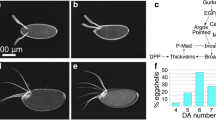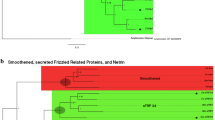Abstract
The development of multicellular embryos depends on coordinated cell-to-cell signalling events. Among the numerous cell-signalling pathways, fibroblast growth factors (FGFs) are involved in important processes during embryogenesis, such as mesoderm formation during gastrulation and growth. In vertebrates, the Fgf superfamily consists of 22 family members, whereas only few FGFs are contained in the less complex genomes of insects and worms. In the recently sequenced genome of the beetle Tribolium, we identified four Fgf family members representing three subfamilies. Tribolium has Fgf1 genes that are absent in Drosophila but known from vertebrates. By phylogenetic analysis and microsynteny to Drosophila, we further classify Tc-fgf 8 as an ancestor of pyramus and thisbe, the fly Fgf8 genes. Tc-fgf8 expression in the growth zone suggests an involvement in mesoderm formation. In the embryonic head, expression of Tc-fgf8 subdivides the brain into a larger anterior and a smaller posterior region. The Fgf Tc-branchless is expressed in the embryonic tracheal placodes and in various gland-like structures. The expression patterns of the only Tribolium Fgf receptor and the adaptor molecule Downstream-of-Fgfr are largely congruent with Tc-Fgf8 and Tc-bnl. Thus, in contrast to Drosophila, only one Fgf receptor canalises Fgf signalling in different tissues in Tribolium. Our findings significantly advance our understanding of the evolution of Fgf signalling in insects.







Similar content being viewed by others
References
Beiman M, Shilo BZ, Volk T (1996) Heartless, a Drosophila FGF receptor homolog, is essential for cell migration and establishment of several mesodermal lineages. Genes Dev 10:2993–3002
Boulet AM, Moon AM, Arenkiel BR, Capecchi MR (2004) The roles of Fgf4 and Fgf8 in limb bud initiation and outgrowth. Dev Biol 273:361–372
Branda CS, Stern MJ (2000) Mechanisms controlling sex myoblast migration in Caenorhabditis elegans hermaphrodites. Dev Biol 226:137–151
Chi CL, Martinez S, Wurst W, Martin GR (2003) The isthmic organizer signal FGF8 is required for cell survival in the prospective midbrain and cerebellum. Development 130:2633–2644
Cohen SM, Jürgens G (1989) Proximal–distal pattern formation in Drosophila: cell autonomous requirement for Distal-less gene activity in limb development. EMBO J 8:2045–2055
Coulier F, Pontarotti P, Roubin R, Hartung H, Goldfarb M, Birnbaum D (1997) Of worms and men: an evolutionary perspective on the fibroblast growth factor (FGF) and FGF receptor families. J Mol Evol 44:43–56
Elsik CG, Mackey AJ, Reese JT, Milshina NV, Roos DS, Weinstock GM (2007) Creating a honey bee consensus gene set. Genome Biol 8:R13
Fambrough D, McClure K, Kazlauskas A, Lander ES (1999) Diverse signaling pathways activated by growth factor receptors induce broadly overlapping, rather than independent, sets of genes. Cell 97:727–741
Gisselbrecht S, Skeath JB, Doe CQ, Michelson AM (1996) heartless encodes a fibroblast growth factor receptor (DFR1/DFGF-R2) involved in the directional migration of early mesodermal cells in the Drosophila embryo. Genes Dev 10:3003–3017
Grieshammer U, Cebrian C, Ilagan R, Meyers E, Herzlinger D, Martin GR (2005) FGF8 is required for cell survival at distinct stages of nephrogenesis and for regulation of gene expression in nascent nephrons. Development 132:3847–3857
Gryzik T, Müller HA (2004) FGF8-like1 and FGF8-like2 encode putative ligands of the FGF receptor Htl and are required for mesoderm migration in the Drosophila gastrula. Curr Biol 14:659–667
Handel K, Basal A, Fan X, Roth S (2005) Tribolium castaneum twist: gastrulation and mesoderm formation in a short-germ beetle. Dev Genes Evol 215:13–31
Harmer NJ (2006) Insights into the role of heparan sulphate in fibroblast growth factor signalling. Biochem Soc Trans 34:442–445
Hirth F, Kammermeier L, Frei E, Walldorf U, Noll M, Reichert H (2003) An urbilaterian origin of the tripartite brain: developmental genetic insights from Drosophila. Development 130:2365–2373
Huang P, Stern MJ (2005) FGF signaling in flies and worms: more and more relevant to vertebrate biology. Cytokine Growth Factor Rev 16:151–158
Huet C, Lenoir-Rousseaux JJ (1976) Adult leg development of Tenebrio molitor: I. Experimental analysis of the restoration process during morphogenesis. J Embryol Exp Morphol 35:303–321
Imai KS, Satoh N, Satou Y (2002) Region specific gene expressions in the central nervous system of the ascidian embryo. Mech Dev 119(Suppl 1):S275–S277
Imai KS, Levine M, Satoh N, Satou Y (2006) Regulatory blueprint for a chordate embryo. Science 312:1183–1187
Itoh N, Ornitz DM (2004) Evolution of the Fgf and Fgfr gene families. Trends Genet 20:563–569
Kerber B, Fellert S, Hoch M (1998) Seven-up, the Drosophila homolog of the COUP-TF orphan receptors, controls cell proliferation in the insect kidney. Genes Dev 12:1781–1786
Kim C (1959) The differentiation centre inducing the development from larval to adult leg in Pieris brassicae (Lepidoptera). J Embryol Exp Morphol 7:572–582
Klämbt C, Glazer L, Shilo BZ (1992) Breathless, a Drosophila FGF receptor homolog, is essential for migration of tracheal and specific midline glial cells. Genes Dev 6:1668–1678
Klingler M, Gergen JP (1993) Regulation of runt transcription by Drosophila segmentation genes. Mech Dev 43:3–19
Kuske G (1963) Untersuchungen zur Metamorphose der Schmetterlingsbeine. Roux’ Archiv für Entwicklungsmechanik 154:354–377
Kuske G, Penner M, Piepho H (1961) Zur Metamorphose des Schmetterlingsbeines. Biol Zbl 80:347–351
Lichtneckert R, Reichert H (2005) Insights into the urbilaterian brain: conserved genetic patterning mechanisms in insect and vertebrate brain development. Heredity 94:465–477
Maqbool T, Soler C, Jagla T, Daczewska M, Lodha N, Palliyil S, Vijayraghavan K, Jagla K (2006) Shaping leg muscles in Drosophila: role of ladybird, a conserved regulator of appendicular myogenesis. PLoS ONE 1:e122
Min H, Danilenko DM, Scully SA, Bolon B, Ring BD, Tarpley JE, DeRose M, Simonet WS (1998) Fgf-10 is required for both limb and lung development and exhibits striking functional similarity to Drosophila branchless. Genes Dev 12:3156–3161
Ornitz DM, Itoh N (2001) Fibroblast growth factors. Genome Biol 2:REVIEWS3005
Parthasarathy R, Gopinathan KP (2005) Comparative analysis of the development of the mandibular salivary glands and the labial silk glands in the mulberry silkworm, Bombyx mori. Gene Expression Patterns 5:323–339
Peters K, Werner S, Liao X, Wert S, Whitsett J, Williams L (1994) Targeted expression of a dominant negative FGF receptor blocks branching morphogenesis and epithelial differentiation of the mouse lung. EMBO J 13:3296–3301
Popovici C, Roubin R, Coulier F, Birnbaum D (2005) An evolutionary history of the FGF superfamily. Bioessays 27:849–857
Reichert H (2005) A tripartite organization of the urbilaterian brain: developmental genetic evidence from Drosophila. Brain Res Bull 66:491–494
Reuss B, von Bohlen und Halbach O (2003) Fibroblast growth factors and their receptors in the central nervous system. Cell Tissue Res 313:139–157
Rhinn M, Picker A, Brand M (2006) Global and local mechanisms of forebrain and midbrain patterning. Curr Opin Neurobiol 16:5–12
Sato M, Kornberg TB (2002) FGF is an essential mitogen and chemoattractant for the air sacs of the Drosophila tracheal system. Dev Cell 3:195–207
Sato T, Joyner AL, Nakamura H (2004) How does Fgf signaling from the isthmic organizer induce midbrain and cerebellum development? Dev Growth Differ 46:487–494
Savard J, Tautz D, Richards S, Weinstock GM, Gibbs RA, Werren JH, Tettelin H, Lercher MJ (2006) Phylogenomic analysis reveals bees and wasps (Hymenoptera) at the base of the radiation of Holometabolous insects. Genome Res 16:1334–1338
Schlessinger J, Plotnikov AN, Ibrahimi OA, Eliseenkova AV, Yeh BK, Yayon A, Linhardt RJ, Mohammadi M (2000) Crystal structure of a ternary FGF–FGFR–heparin complex reveals a dual role for heparin in FGFR binding and dimerization. Mol Cell 6:743–750
Schröder R, Eckert C, Wolff C, Tautz D (2000) Conserved and divergent aspects of terminal patterning in the beetle Tribolium castaneum. Proc Natl Acad Sci USA 97:6591–6596
Shishido E, Higashijima S, Emori Y, Saigo K (1993) Two FGF-receptor homologues of Drosophila: one is expressed in mesodermal primordium in early embryos. Development 117:751–761
Simon MA (2000) Receptor tyrosine kinases: specific outcomes from general signals. Cell 103:13–15
Stathopoulos A, Tam B, Ronshaugen M, Frasch M, Levine M (2004) Pyramus and thisbe: FGF genes that pattern the mesoderm of Drosophila embryos. Genes Dev 18:687–699
Sun X, Meyers EN, Lewandoski M, Martin GR (1999) Targeted disruption of Fgf8 causes failure of cell migration in the gastrulating mouse embryo. Genes Dev 13:1834–1846
Sun X, Mariani FV, Martin GR (2002) Functions of FGF signalling from the apical ectodermal ridge in limb development. Nature 418:501–508
Sutherland D, Samakovlis C, Krasnow MA (1996) Branchless encodes a Drosophila FGF homolog that controls tracheal cell migration and the pattern of branching. Cell 87:1091–1101
Takashima S, Murakami R (2001) Regulation of pattern formation in the Drosophila hindgut by wg, hh, dpp, and en. Mech Dev 101:79–90
Tautz D, Pfeifle C (1989) A non-radioactive in situ hybridization method for the localization of specific RNAs in Drosophila embryos reveals translational control of the segmentation gene hunchback. Chromosoma 98:81–85
Thisse B, Thisse C (2005) Functions and regulations of fibroblast growth factor signaling during embryonic development. Dev Biol 287:390–402
Trumpp A, Depew MJ, Rubenstein JL, Bishop JM, Martin GR (1999) Cre-mediated gene inactivation demonstrates that FGF8 is required for cell survival and patterning of the first branchial arch. Genes Dev 13:3136–3148
Vincent S, Wilson R, Coelho C, Affolter M, Leptin M (1998) The Drosophila protein Dof is specifically required for FGF signaling. Mol Cell 2:515–525
Wilson R, Vogelsang E, Leptin M (2005) FGF signalling and the mechanism of mesoderm spreading in Drosophila embryos. Development 132:491–501
Wolff C, Sommer R, Schröder R, Glaser G, Tautz D (1995) Conserved and divergent expression aspects of the Drosophila segmentation gene hunchback in the short germ band embryo of the flour beetle Tribolium. Development 121:4227–4236
Acknowledgements
We thank R. Reuter for constant encouraging support, T. Mader for technical help and F. Beermann for comments on the manuscript. Our work is financed by the German Research Council (DFG) grant SCHR 435/3 1-3).
Author information
Authors and Affiliations
Corresponding author
Additional information
Communicated by S. Roth
Rights and permissions
About this article
Cite this article
Beermann, A., Schröder, R. Sites of Fgf signalling and perception during embryogenesis of the beetle Tribolium castaneum . Dev Genes Evol 218, 153–167 (2008). https://doi.org/10.1007/s00427-007-0192-x
Received:
Accepted:
Published:
Issue Date:
DOI: https://doi.org/10.1007/s00427-007-0192-x




